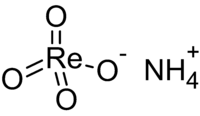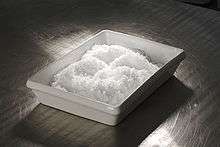Ammonium perrhenate
 | |
 | |
| Names | |
|---|---|
| Other names
Ammonium perrhenate, Ammonium perrhenate(VII) | |
| Identifiers | |
| 13598-65-7 | |
| ChemSpider | 2341271 |
| Jmol interactive 3D | Image |
| |
| |
| Properties | |
| NH4ReO4 | |
| Molar mass | 268.2359 g/mol |
| Density | 3.97 g/cm3, solid |
| Melting point | °C |
| 2.8 g/100 mL (0 °C), 6.2 g/100 mL (20 °C), 12.0 g/100 mL (40 °C), 20.7 g/100 mL (60 °C), 32.3 g/100 mL (80 °C), 39.1 g/100 mL (90 °C) | |
| Structure | |
| scheelite | |
| N/A | |
| Hazards | |
| EU classification (DSD) |
Not listed. |
| Flash point | Non-flammable |
| Related compounds | |
| Other anions |
Ammonium manganate; ammonium pertechnetate |
| Other cations |
Sodium perrhenate; perrhenic acid |
| Except where otherwise noted, data are given for materials in their standard state (at 25 °C [77 °F], 100 kPa). | |
| | |
| Infobox references | |
Ammonium perrhenate (APR) is the ammonium salt of perrhenic acid, NH4ReO4. It is the most common form in which rhenium is traded. It is a white, water-soluble salt. It was first described soon after the discovery of rhenium.[1]
Structure

The crystal structure of APR is that of scheelite, in which the atomic cation is replaced by the ammonium molecular cation.[2] It undergoes a molecular orientational ordering transition on cooling without change of space group, but with a highly anisotropic change in the shape of the unit cell, resulting in the unusual property of having a positive temperature and pressure Re NQR coefficient.[3]
NH4ReO4 can be regarded as the prototype structure of a family of ammonium scheelites, which include the pertechnetate (NH4TcO4), periodate (NH4IO4), tetrachlorothallate (NH4TlCl4) and tetrachloroindate (NH4InCl4).[2]
Preparation
Ammonium perrhenate may be prepared from virtually all common sources of rhenium. The metal, oxides, and sulfides can be oxidized with nitric acid and the resulting solution treated with aqueous ammonia. Alternatively an aqueous solution of Re2O7 can be treated with ammonia followed by crystallisation.[4][5]
Reactions
Pure rhenium powder can be produced from APR by heating it in the presence of hydrogen:[4]
- 2 NH4ReO4 + 7 H2 → 2 Re + 8 H2O + 2 NH3
Heating must be done slowly because ammonium perrhenate decomposes to volatile Re2O7 starting at 250 °C. When heated in a sealed tube at 500 °C, APR decomposes to rhenium dioxide:[4]
- 2NH4ReO4 → 2ReO2 + N2 + 4 H2O
References
- ↑ Noddack, J.; Noddack, W. (1929). "Die Sauerstoffverbindungen des Rheniums". Zeitschrift für anorganische und allgemeine Chemie 181: 1–37. doi:10.1002/zaac.19291810102.
- 1 2 I. P. Swainson and R. J. C. Brown (1997). "Refinement of ammonium perrhenate structure using a pseudo-spin model for the ammonium ion orientation". Acta Crystallographica B53: 76–81. doi:10.1107/S0108768196011160.
- ↑ R. J. C. Brown and S. L. Segel (1977). "187Re, 14N, and 2H nuclear quadrupole couplings in NH4ReO4: Evidence for a possible phase transition". Journal of Chemical Physics 67 (7): 3163–7. doi:10.1063/1.435229.
- 1 2 3 O. Glemser "Ammonium Perrhenate" in Handbook of Preparative Inorganic Chemistry, 2nd Ed. Edited by G. Brauer, Academic Press, 1963, New York. vol. 1. p. 1476–85.
- ↑ Richard J. Thompson (1966). "Ammonium Perrhenate". Inorganic Syntheses 8: 171–173. doi:10.1002/9780470132395.ch44.
- Wm. T. Smith, S. Harmon Long (1948). "The Salts of Perrhenic Acid. I. The Alkali Metals and Ammonium". Journal of the American Chemical Society 70 (1): 354–356. doi:10.1021/ja01181a110.
| ||||||||||||||||||||||||||||||||||||||||